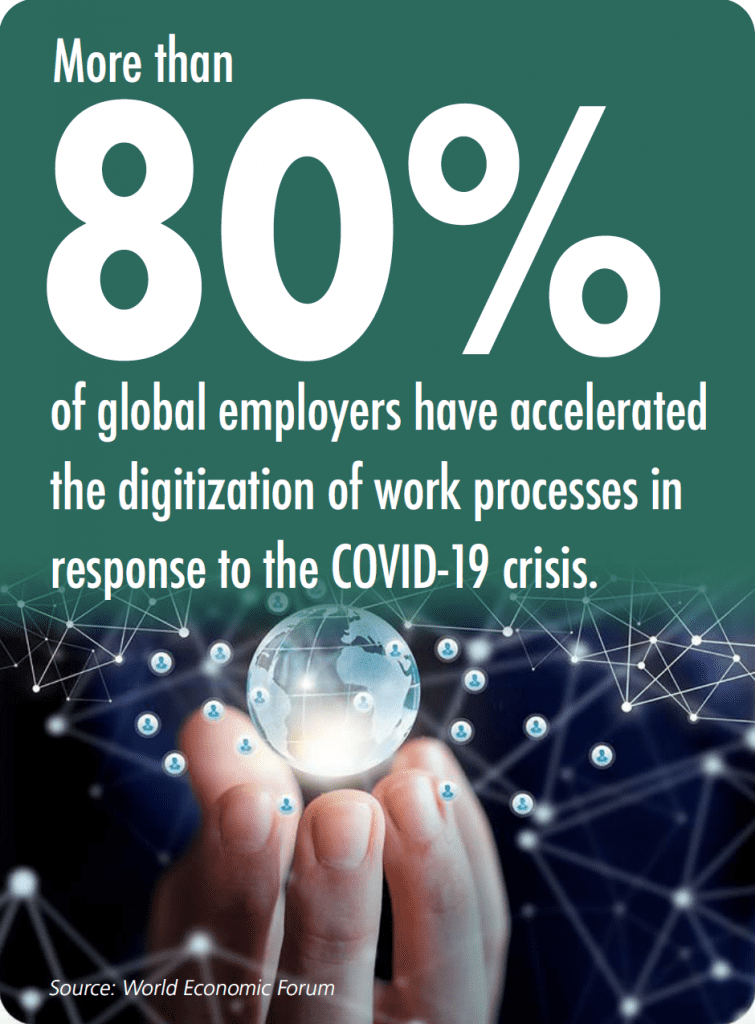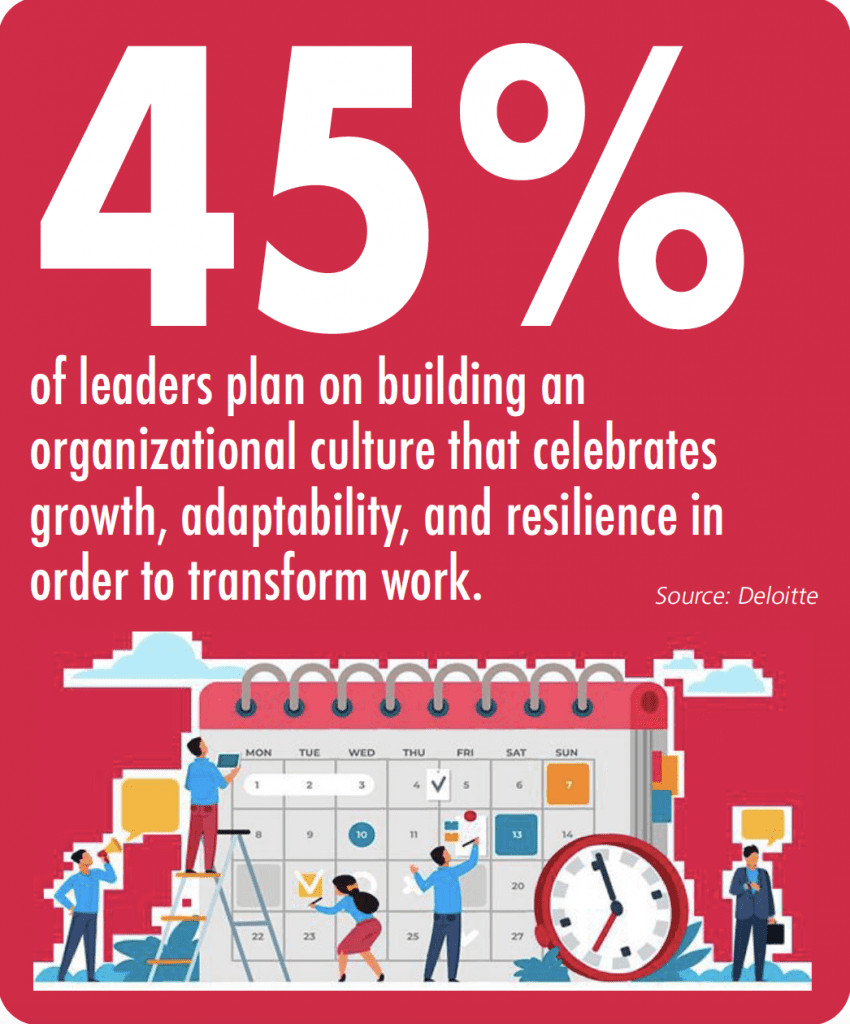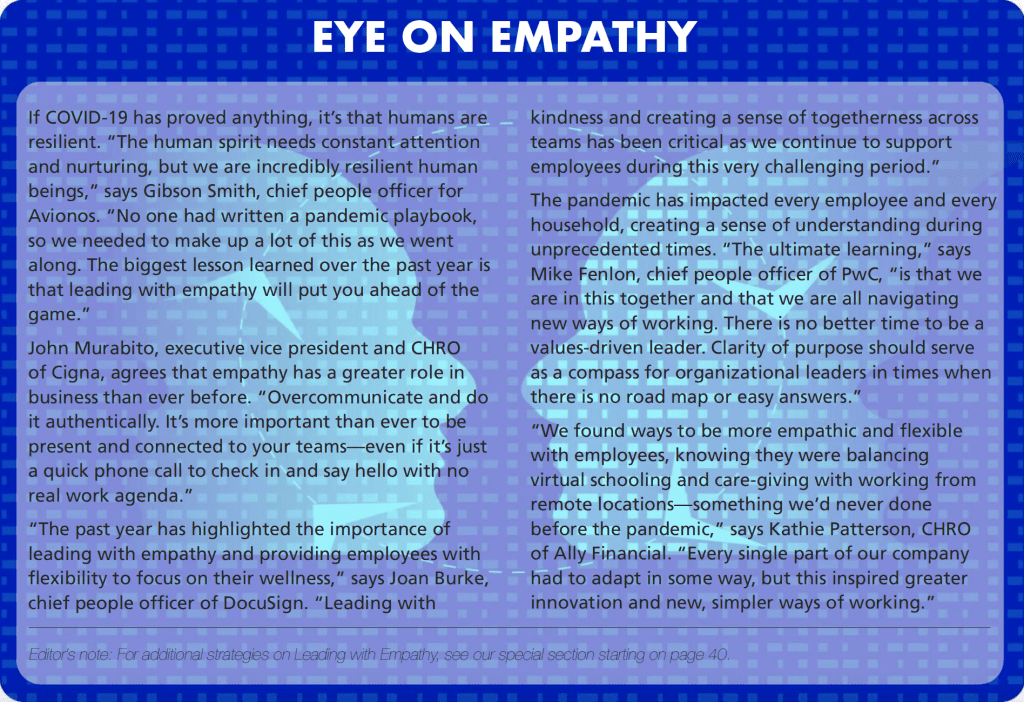Seven CHROs share the new realities of work and how the challenges of 2020 have driven them to make disruptive change.
By Debbie Bolla
“Empathy, flexibility, and resiliency defined 2020,” says Kathie Patterson, CHRO of Ally Financial. Taking a closer look, Patterson couldn’t be more spot-on.
As defined by Merriam-Webster:
- empathy is the action of understanding, being aware of, being sensitive to, and vicariously experiencing the feelings, thoughts, and experience of another;
- flexibility is characterized by a ready capability to adapt to new, different, or changing requirements; and
- resiliency is an ability to recover from or adjust easily to adversity or change.
HR leaders had to face the enormous challenges of the past year with these three attributes guiding their actions. Mai Lan Nguyen, senior vice president of HR in North America for Schneider Electric, says COVID-19 has been a real-life test of resiliency, calling for organizations to reimagine the way business gets done. Technology has been a game-changer in her company’s approach, allowing the business to stay connected while pushing new ideas to fruition.
“While digitization was already a key part of our HR strategy at Schneider Electric, it’s played a significant role in helping us start to shape the workplace of the future, to brainstorm effective talent strategy and retention efforts, and to enhance the flexibility of our work policies.”
For example, Schneider Electric drew inspiration from the gig economy and launched its “Open Talent Marketplace” (OTM). OTM is an AI-driven platform that connects employees who are looking to grow their skills with short-term projects. It also encourages mentorship within the organization.
“It’s been a win-win for us,” Nguyen says. “Participation in OTM has been a tremendous success as we’ve completed more than 45,000 hours of work in the marketplace since its launch. Employees are being matched to work on a particular assignment they find most intriguing, resulting in teams with a diverse mix of backgrounds and experiences to find solutions.”

Remote work has also forced organizations to redefine how they approach and embrace workplace flexibility. John Murabito, executive vice president and CHRO of Cigna, says the line between work and life has become non-existent, with employees getting their jobs done from anywhere the house allows -the guest room, the basement, and even the kitchen table.
“It’s really difficult to maintain work-life balance while dealing with some very intense personal responsibilities, coupled with day-to-day professional roles,” he says. This is where flexibility comes into play: “We’ve made a conscious effort to work with our leaders to underscore the importance and expectation of flexibility with our teams. Maybe it’s non-traditional hours, job-sharing, or taking the ‘emergency time-off’ we instituted for any COVID-related reason, but our message has been clear. Meet your teams where they are and work to address any roadblocks or barriers to help them do their work,” Murabito explains.
That people-first approach resonates with organizations that are looking to support both the physical and mental well-being of employees during a very stressful time. “Every person has a different set of needs and is dealing with their own unique circumstances in their personal and professional lives,” says Mike Fenlon, chief people officer of PwC. “While PwC has long offered a number of flexible work options and care benefits, we realized that given the current environment, we needed to expand upon our existing offerings and that there is simply no one-size-fits-all approach to meeting the needs of our people. ”
To meet employees where they are during the pandemic, PwC provides benefits that run the gamut and include:
- employee-created work schedules through formal and informal flexibility options;
- an emergency $2,000 childcare reimbursement;
- a six-month leave of absence option that allows employees to retain 20% of their pay; and
- increased mental health support offerings, including free virtual therapy sessions and mindfulness resources.
The circumstances of the pandemic also forced organizations to redesign the employee experience in order to keep engagement levels high.
“Over the course of the pandemic, we quickly saw an opportunity to improve the way our employees experience the DocuSign culture,” says Chief People Officer Joan Burke. “We reimagined our onboarding experience, created cohort groups for employees to connect, and challenged ourselves to think creatively about how we reinforce inclusion. We have been pleased to see that our engagement scores during this period continue to remain very high.”
Joining a new company while working remotely can present some obstacles, so DocuSign acted very thoughtfully to ensure newly hired employees feel connected to the company culture. To enhance virtual communications, new hires have their own community via a Slack channel and the company’s internal platform “DocuSign Learning.”
“Additionally, we created a 24-hour virtual Zoom coffee break so that employees from all over the world have the opportunity to join the platform and meet in a friendly, low pressure way,” she says.
In a new virtual reality, leadership and employee support is more important than ever, and managers are a crucial piece of that puzzle. For DocuSign, investing in people managers is key to helping employees work to their fullest potential.
“It’s been important to find new ways to support our managers with new tools and new resources so that they feel comfortable leading in this remote environment,” explains Burke. “For instance, one of our programs focuses on helping managers understand the power of tailoring motivation and rewards to what is meaningful to the individual. In other words, one size fits one.”
With no timeframe for the pandemic’s length, Gibson Smith, chief people officer of Avionos, led with the future in mind. “All of the programs we put in place were focused on longer term approaches versus quick hits or quick wins because we wanted to make sure we created some structure of new normalcy for the long haul,” he explains.

- creating a heightened sense of engagement;
- reducing isolation;
- increasing general comradery;
- developing social bonds;
- offering regular cadence for check-ins; and
- creating small communities within the larger organization.
With the pandemic proving how agile and adaptable organizations can be, some newer approaches are likely to stick around. “I think flexible schedules will be ingrained into most organizations as the norm now,” Smith says. “Balancing onsite and distributed environments will be a discussion topic for leadership moving forward.”
Murabito agrees. “In the past, there were some roles that we felt couldn’t -or shouldn’t -be done at home. That theory no longer applies as the vast majority of our employees are working at home now and have been since last March. It’s been a good lesson for us to learn. Our internal surveys tell us that employees really value the flexibility that comes with working at home and largely want to continue to work this way in the future. So now, our challenge is to figure out how best to enable that and continue to build and enhance our workplace culture and connectedness.”
DocuSign is zeroing in on a culture of inclusion in anticipation of the shift to a hybrid model -a blend of in-office and remote workers -once office spaces completely reopen. “There’s a need for HR to rethink, and help managers rethink, how we get work done and with what tools while engaging and empowering employees,” Burke explains.
For a hybrid model to be successful, she says organizations should continue leveraging tools like Slack and Zoom and reimburse employees for the expenses that come with working from home. But good execution will depend on HR leaders’ ability to keep the lines of communication open. With that in mind, feedback from regular employee engagement surveys can help guide strategy.
“As we look ahead, we will take our learnings from this year and continue with an employee-first approach across the board, regardless of where they’re working,” she says.
Ally Financial’s Patterson says that moving forward, employees will expect more flexibility in their jobs and companies will need to adapt. “We firmly believe in the powerful, positive cultural impact that having employees in facilities together brings,” she explains. “Ally is not a company that will go fully virtual. We get too much energy, creativity, and efficiencies from the collaboration that can only happen face-to-face. But we will need to approach things with our employees in new ways that make it easier to balance personal demands with that of the business, ensuring Ally is a place people want to work, where they can grow and develop both personally and professionally.”
Nguyen believes digitization’s impact will continue in 2021, shaping how organizations grow and retain talent. “The acceleration of digitization and automation will drive us to innovate more and therefore prompt organizations to reskill and upskill existing talent,” she says. “From my view as an HR leader, this means nurturing a culture of continuous learning and formalizing ongoing talent development programs as the vertical career progression model of yesterday falls to the side.”















